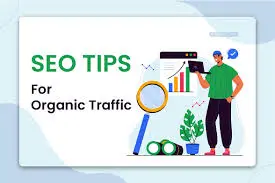SEO Strategies For Organic Traffic
In the competitive digital landscape, driving organic traffic is essential for long-term success. It represents visitors who find your website through unpaid search results, offering a sustainable and cost-effective way to grow your online presence. Here are the key SEO strategies to boost your organic traffic.
1. Conduct Comprehensive Keyword Research in SEO Strategies for Organic Traffic
Keywords are the foundation of SEO. To drive organic traffic, you need to understand what your audience is searching for and tailor your content accordingly.
Target Keywords: Use tools like Google Keyword Planner or Ahrefs to find high-volume, low-competition keywords. Make sure your keywords are long-tail and align with the user’s intent.
Competitor Analysis: Examine the keywords your competitors rank for to identify gaps in your strategy and uncover new opportunities.
User Intent: Prioritize understanding the intent behind searches—whether users are seeking information, products, or solutions—and create content that meets these needs.
Effective keyword research ensures your content is relevant and targets the right audience, making it more likely to attract organic traffic.
2. Optimize On-Page SEO Strategies for Organic Traffic
In on-page SEO, you optimize individual pages on your site so that they rank higher in search engine results, which is important for driving organic traffic to your site.
Title Tags and Meta Descriptions: Craft compelling title tags and meta descriptions that include your target keywords and entice users to click.
Header Tags: Use header tags (H1, H2, H3) to structure your content, improving readability and SEO.
Internal Linking: Establish a strong internal linking structure to connect related content and enhance both user experience and SEO.
Image Optimization: Include alt text for images and ensure they are optimized for fast loading, which can help with image search rankings.
Optimizing on-page elements helps search engines understand your content, improving your chances of ranking well.
3. Create High-Quality, Engaging Content
Content is a key driver of organic traffic. To succeed, your content must be valuable, relevant, and engaging.
In-Depth Articles: Focus on creating comprehensive, long-form content that thoroughly addresses topics of interest to your audience.
Regular Updates: Keep your content fresh and relevant by regularly updating it with new information.
Diverse Formats: Use a mix of content formats—blogs, videos, infographics—to appeal to different audience preferences.
Answer Questions: Create content that answers common questions in your niche, using tools like AnswerThePublic to identify these queries.
High-quality content not only ranks better but also keeps users on your site longer, sending positive signals to search engines.
4. Build a Strong Backlink Profile
Backlinks are a major factor in driving organic traffic, signaling to search engines that your content is authoritative.
Guest Blogging: Write guest posts for reputable sites to gain exposure and earn quality backlinks.
Outreach: Promote your content to influencers and industry leaders who might link to it.
Link-Worthy Content: Create valuable content like original research or infographics that naturally attracts backlinks.
Broken Link Building: Replace broken links with your content on relevant websites.
A strong backlink profile boosts your site’s authority and improves your chances of ranking for competitive keywords.
5. Enhance User Experience (UX) and Site Structure
A well-structured, user-friendly website improves both SEO and user engagement, essential for driving organic traffic.
Mobile Optimization: Ensure your site is mobile-friendly, as more users are searching on mobile devices.
Site Speed: Optimize your site’s loading time, as slow sites can lead to higher bounce rates and lower rankings.
Clear Navigation: Create an intuitive navigation structure that helps users find what they’re looking for easily.
Engaging Visuals: Use images and videos to make your content more engaging and reduce bounce rates.
Improving user experience encourages visitors to stay longer, explore more pages, and convert, all of which contribute to better SEO.
6. Leverage Social Media for SEO Strategies for Organic Traffic
While social media doesn’t directly affect SEO rankings, it plays a crucial role in increasing your content’s visibility and driving traffic.
Content Sharing: Regularly promote your content on social media to reach a wider audience and drive traffic.
Audience Engagement: Build a community by engaging with your followers and encouraging them to share your content.
Social Sharing Buttons: Make it easy for visitors to share your content by adding social sharing buttons to your site.
Social media can amplify your content’s reach and lead to more organic traffic over time.
Conclusion
Driving organic traffic requires a well-rounded SEO strategy that focuses on keyword research, on-page optimization, high-quality content, backlinks, user experience, and social media. By implementing these strategies, you can improve your website’s visibility, attract more visitors, and grow your business. SEO is a continuous process that evolves with your business. Regularly monitor your performance and adapt to changes in search algorithms and user behavior to maintain and increase your organic traffic. With these strategies in place, you’ll be well-equipped to drive sustainable, long-term growth through organic search.
